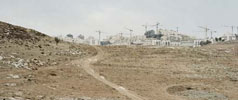| The publication of the book title ‘City of Collision‘ (pdf with list of content) yesterday evening at the Academy of Arts, Berlin, has been accompanied by |   |
about two hours of talks and disscusions which attempted to focus on the recent threats and consequential developments in connection with the specific spatial configuration of Jerusalem.
Among the participants E. Weizman was the clearest to point out that a comparison like this never can be acchieved on an easy level. A generalisation of the situation of Jerusalem neither works via the israelization of american policiy nor through the equalization of the specific palestinian situation with other spatial related conflicts and thus does effectively contribute on a general level to discussion on terror and ‘war on freedom’ issues. The complexity and the level of interconnection roots much deeper within this specific multilayered conflict, nevertheless some occurances might hint to general developments … or viceversa.
| Consequently this understanding is more likely to be reflected by Peter Marcuse‘s comment that urban structures can be read like molecules displaying formatting patterns of |  Road systems: Har Homa / Sur Bahir |
cultural development and thereby evolving into their specific shape. In this sense Sari Hanafi‘s lecture about the spatio-cide structure of israelian bio-politics, accumulating in the attempts of making ‘the other’ (Palestinians) invisible, contributed as an analysis of the erasure of spatial memory or the disconnection between space and the memory of the inhabitants of the specified space to this approach. (In my opinion a good visualization of a similar spatial analysis is given in Weizman’s earlier work of ‘Politics of Verticality‘.)
Interesting as an initial thought yesterday was surely as well Weizman’s comment that architectural form always also displays a certain incorporated flexibility of politics and rarely just emerges from a straight transformation of drawn lines. The example he gave here was the dividing wall, which surely never to the palestinian benefit – as anyway on their territory and beyond the green line – was eventually moved a little bit west according to ease some too rude circumstances of seperation of land/culture occuring during its construction. At the same time noting that this happened to stay just a little bit below that fine line that kept the humanitarian desaster of the Palestinians on a level beyond an international outcry against this steady humiliation …
